2000 MERCEDES-BENZ S500 Safety lock
[x] Cancel search: Safety lockPage 4 of 421

1 Contents
IntroductionProduct information .......................... 7
Operator’s manual ............................. 8
Where to find it ................................ 13
Reporting Safety Defects ................ 15Instruments and controlsInstruments and controls ............... 18
Door control panel ....................... 20
Overhead control panel ............... 21
Dashboard ..................................... 22
Center console .............................. 24OperationVehicle keys ...................................... 28
Start lock-out .................................... 32
General notes on the
central locking system ............... 33
Central locking system ................... 34
Radio frequency and
infrared remote control ............... 34
KEYLESS-GO ................................. 38Opening and
closing windows and
sliding / pop-up roof
from outside ................................. 45
Panic button ................................. 47
Mechanical keys .......................... 47
Doors ................................................. 48
Power closing assist for
doors and trunk lid .................... 50
Central locking switch .................... 50
Automatic central locking .............. 52
Emergency unlocking
in case of accident ...................... 52
Trunk ................................................. 53
Trunk lid release switch ................ 57
Trunk lid release/close switch ...... 58
Trunk lid emergency release .........61
Antitheft alarm system ................... 62
Tow-away alarm ............................... 64
Easy-entry/exit feature .................. 66
Front seat adjustment ..................... 67
Removal and installation
of front seat head restraints ..... 72
Lumbar support ............................... 73Multicontour backrest ..................... 73
Seat heater ........................................ 75
Seat ventilation system ................... 78
Rear seat head restraints ................ 80
Power head restraints, rear ............ 81
Power seats, rear .............................. 82
Seat belts and integrated
restraint system .......................... 84
Seat belts ........................................... 84
Seat belt nonusage
warning system ........................... 85
BabySmart
TM airbag
deactivation system .................... 91
Self-test BabySmart
TM
without special child
seat installed ................................. 91
Supplemental Restraint
System (SRS) ............................... 92
Emergency tensioning
retractor (ETR) ............................. 93
Airbags .............................................. 94
Safety guidelines for the
seat belt, emergency
tensioning retractor
and airbag .................................. 100
Page 29 of 421

26 Contents - Operation
Te ch n ica l
data Instruments
and controlsOperationDrivingInstrument
cluster displayPractical hints Car care Index
OperationVehicle keys ...................................... 28
Start lock-out .................................... 32
General notes on the
central locking system ............... 33
Central locking system ................... 34
Radio frequency and
infrared remote control ............... 34
KEYLESS-GO ................................. 38
Opening and
closing windows and
sliding / pop-up roof
from outside .................................. 45
Panic button .................................. 47
Mechanical keys ........................... 47
Doors .................................................. 48
Power closing assist for
doors and trunk lid ..................... 50
Central locking switch .................... 50
Automatic central locking .............. 52
Emergency unlocking
in case of accident ...................... 52
Trunk ................................................. 53
Trunk lid release switch ................. 57Trunk lid release/close switch ...... 58
Trunk lid emergency release .........61
Antitheft alarm system ................... 62
Tow-away alarm ............................... 64
Easy-entry/exit feature .................. 66
Front seat adjustment ..................... 67
Removal and installation
of front seat head restraints ..... 72
Lumbar support ............................... 73
Multicontour backrest .................... 73
Seat heater ........................................ 75
Seat ventilation system .................. 78
Rear seat head restraints ............... 80
Power head restraints, rear ............ 81
Power seats, rear ............................. 82
Seat belts and integrated
restraint system .......................... 84
Seat belts .......................................... 84
Seat belt nonusage
warning system .......................... 85
BabySmart
TM airbag
deactivation system ....................91Self-test BabySmart
TM
without special child
seat installed ................................. 91
Supplemental Restraint
System (SRS) ............................... 92
Emergency tensioning
retractor (ETR) ............................. 93
Airbags .............................................. 94
Safety guidelines for the
seat belt, emergency
tensioning retractor
and airbag .................................. 100
Infant and child restraint
systems ....................................... 102
Steering wheel adjustment .......... 105
Rear view mirrors .......................... 106
Memory function ............................ 111
Instrument cluster ..........................114
Multifunction steering wheel,
multifunction display ............... 120
Trip and main odometer,
FSS, tire inf lation pressure
monitor and engine oil level
indicator ..................................... 124
Audio systems ............................. 125
Page 83 of 421
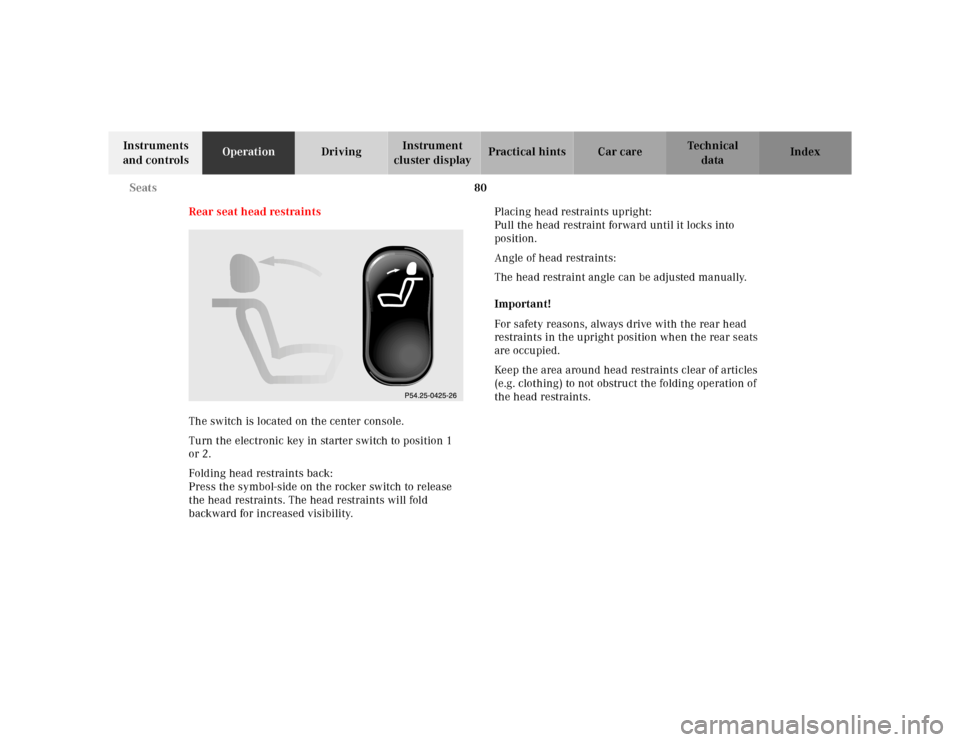
80 Seats
Te ch n ica l
data Instruments
and controlsOperationDrivingInstrument
cluster displayPractical hints Car care Index
Rear seat head restraints
The switch is located on the center console.
Turn the electronic key in starter switch to position 1
or 2.
Folding head restraints back:
Press the symbol-side on the rocker switch to release
the head restraints. The head restraints will fold
backward for increased visibility.Placing head restraints upright:
Pull the head restraint forward until it locks into
position.
Angle of head restraints:
The head restraint angle can be adjusted manually.
Important!
For safety reasons, always drive with the rear head
restraints in the upright position when the rear seats
are occupied.
Keep the area around head restraints clear of articles
(e.g. clothing) to not obstruct the folding operation of
the head restraints.
Page 84 of 421
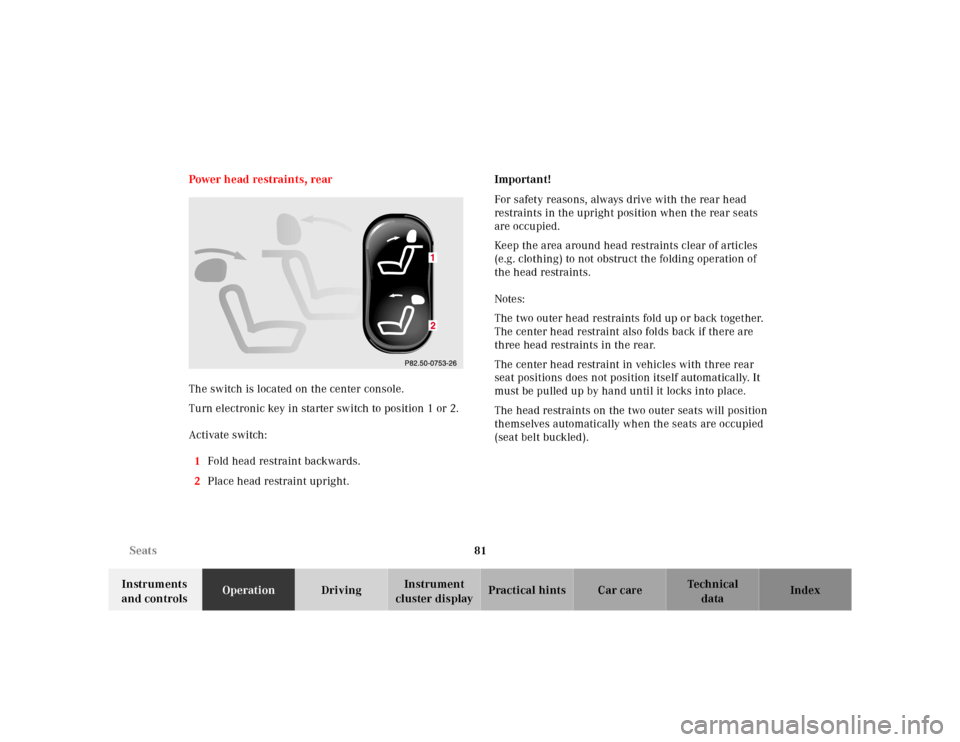
81 Seats
Te ch n ica l
data Instruments
and controlsOperationDrivingInstrument
cluster displayPractical hints Car care Index Power head restraints, rear
The switch is located on the center console.
Turn electronic key in starter switch to position 1 or 2.
Activate switch:
1Fold head restraint backwards.
2Place head restraint upright.Important!
For safety reasons, always drive with the rear head
restraints in the upright position when the rear seats
are occupied.
Keep the area around head restraints clear of articles
(e.g. clothing) to not obstruct the folding operation of
the head restraints.
Notes:
The two outer head restraints fold up or back together.
The center head restraint also folds back if there are
three head restraints in the rear.
The center head restraint in vehicles with three rear
seat positions does not position itself automatically. It
must be pulled up by hand until it locks into place.
The head restraints on the two outer seats will position
themselves automatically when the seats are occupied
(seat belt buckled).
Page 91 of 421
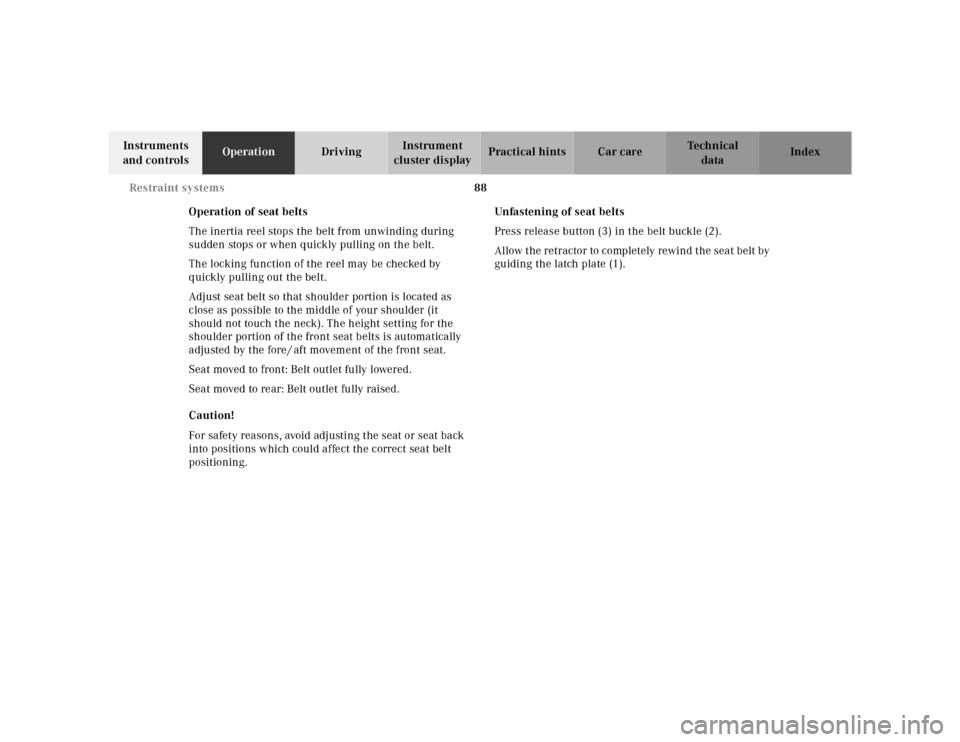
88 Restraint systems
Te ch n ica l
data Instruments
and controlsOperationDrivingInstrument
cluster displayPractical hints Car care Index
Operation of seat belts
The inertia reel stops the belt from unwinding during
sudden stops or when quickly pulling on the belt.
The locking function of the reel may be checked by
quickly pulling out the belt.
Adjust seat belt so that shoulder portion is located as
close as possible to the middle of your shoulder (it
should not touch the neck). The height setting for the
shoulder portion of the front seat belts is automatically
adjusted by the fore / aft movement of the front seat.
Seat moved to front: Belt outlet fully lowered.
Seat moved to rear: Belt outlet fully raised.
Caution!
For safety reasons, avoid adjusting the seat or seat back
into positions which could affect the correct seat belt
positioning.Unfastening of seat belts
Press release button (3) in the belt buckle (2).
Allow the retractor to completely rewind the seat belt by
guiding the latch plate (1).
Page 105 of 421
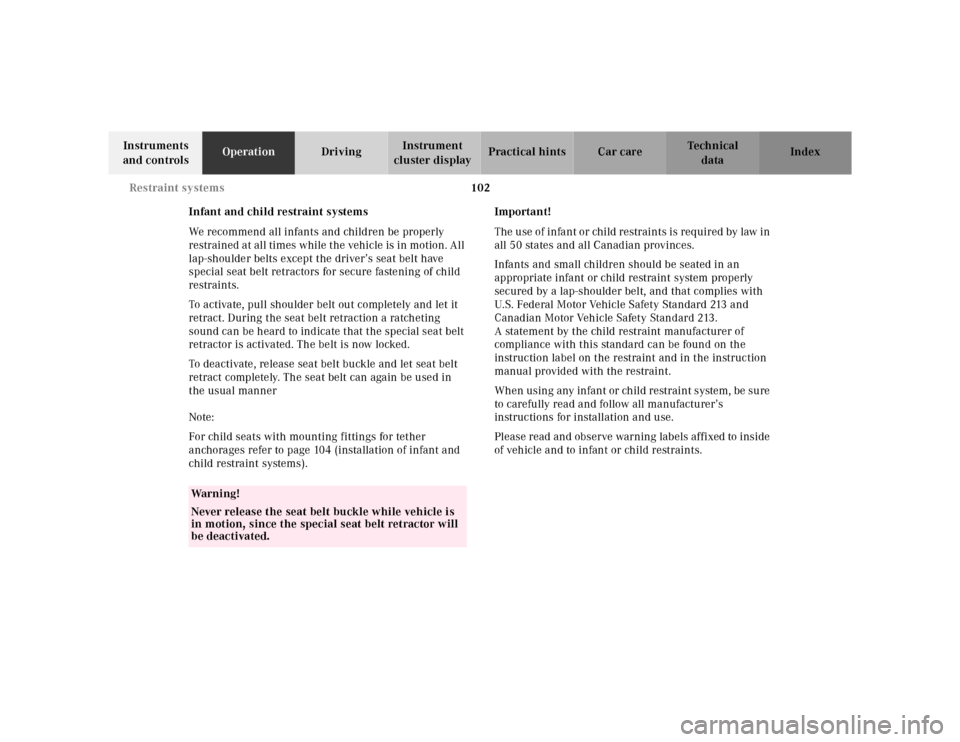
102 Restraint systems
Te ch n ica l
data Instruments
and controlsOperationDrivingInstrument
cluster displayPractical hints Car care Index
Infant and child restraint systems
We recommend all infants and children be properly
restrained at all times while the vehicle is in motion. All
lap-shoulder belts except the driver’s seat belt have
special seat belt retractors for secure fastening of child
restraints.
To activate, pull shoulder belt out completely and let it
retract. During the seat belt retraction a ratcheting
sound can be heard to indicate that the special seat belt
retractor is activated. The belt is now locked.
To deactivate, release seat belt buckle and let seat belt
retract completely. The seat belt can again be used in
the usual manner
Note:
For child seats with mounting fittings for tether
anchorages refer to page 104 (installation of infant and
child restra int systems).Important!
The use of infant or child restraints is required by law in
all 50 states and all Canadian provinces.
Infants and small children should be seated in an
appropriate infant or child restraint system properly
secured by a lap-shoulder belt, and that complies with
U.S. Federal Motor Vehicle Safety Standard 213 and
Canadian Motor Vehicle Safety Standard 213.
A statement by the child restraint manufacturer of
compliance with this standard can be found on the
instruction label on the restraint and in the instruction
manual provided with the restraint.
When using any infant or child restraint system, be sure
to carefully read and follow all manufacturer’s
instructions for installation and use.
Please read and observe warning labels affixed to inside
of vehicle and to infant or child restraints.
Wa r n i n g !
Never release the seat belt buckle while vehicle is
in motion, since the special seat belt retractor will
be deactivated.
Page 165 of 421
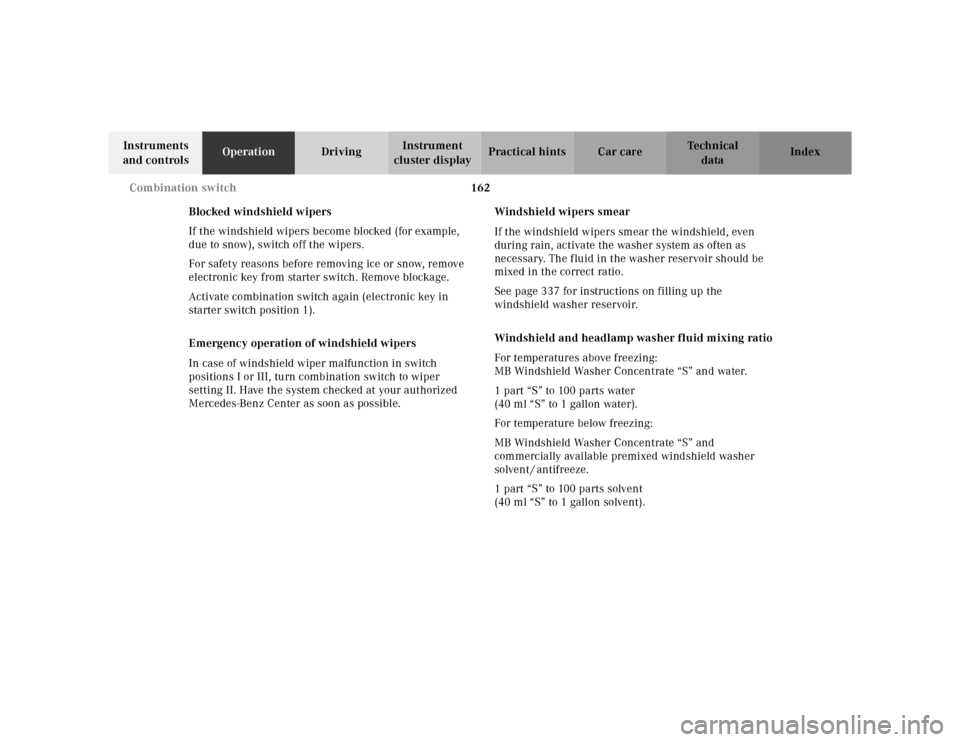
162 Combination switch
Te ch n ica l
data Instruments
and controlsOperationDrivingInstrument
cluster displayPractical hints Car care Index
Blocked windshield wipers
If the windshield wipers become blocked (for example,
due to snow), switch off the wipers.
For safety reasons before removing ice or snow, remove
electronic key from starter switch. Remove blockage.
Activate combination switch again (electronic key in
starter switch position 1).
Emergency operation of windshield wipers
In case of windshield wiper malfunction in switch
positions I or III, turn combination switch to wiper
setting II. Have the system checked at your authorized
Mercedes-Benz Center as soon as possible.Windshield wipers smear
If the windshield wipers smear the windshield, even
during rain, activate the washer system as often as
necessary. The fluid in the washer reservoir should be
mixed in the correct ratio.
See page 337 for instructions on filling up the
windshield washer reservoir.
Windshield and headlamp washer fluid mixing ratio
For temperatures above freezing:
MB Windshield Washer Concentrate “S” and water.
1 part “S” to 100 parts water
(40 ml “S” to 1 gallon water).
For temperature below freezing:
MB Windshield Washer Concentrate “S” and
commercially available premixed windshield washer
solvent / antifreeze.
1 part “S” to 100 parts solvent
(40 ml “S” to 1 gallon solvent).
Page 274 of 421
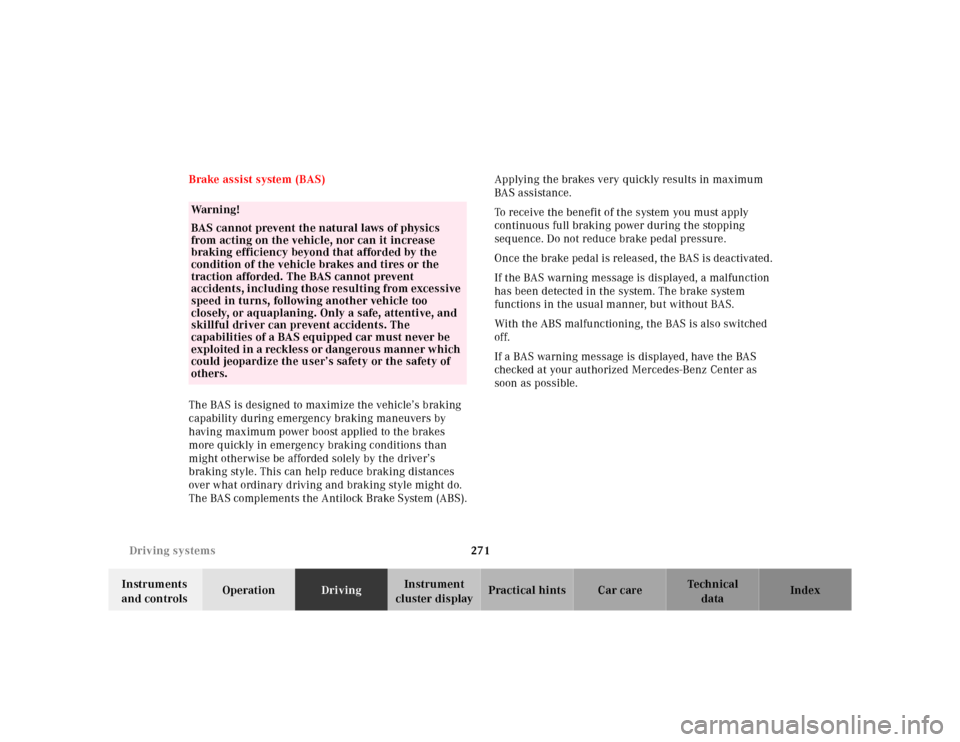
271 Driving systems
Te ch n ica l
data Instruments
and controlsOperationDrivingInstrument
cluster displayPractical hints Car care Index Brake assist system (BAS)
The BAS is designed to maximize the vehicle’s braking
capability during emergency braking maneuvers by
having maximum power boost applied to the brakes
more quickly in emergency braking conditions than
might otherwise be afforded solely by the driver’s
braking style. This can help reduce braking distances
over what ordinary driving and braking style might do.
The BAS complements the Antilock Brake System (ABS).Applying the brakes very quickly results in maximum
BAS assistance.
To receive the benefit of the system you must apply
continuous full braking power during the stopping
sequence. Do not reduce brake pedal pressure.
Once the brake pedal is released, the BAS is deactivated.
If the BAS warning message is displayed, a malfunction
has been detected in the system. The brake system
functions in the usual manner, but without BAS.
With the ABS malfunctioning, the BAS is also switched
off.
If a BAS warning message is displayed, have the BAS
checked at your authorized Mercedes-Benz Center as
soon as possible.
Wa r n i n g !
BAS cannot prevent the natural laws of physics
from acting on the vehicle, nor can it increase
braking efficiency beyond that afforded by the
condition of the vehicle brakes and tires or the
traction afforded. The BAS cannot prevent
accidents, including those resulting from excessive
speed in turns, following another vehicle too
closely, or aquaplaning. Only a safe, attentive, and
skillful driver can prevent accidents. The
capabilities of a BAS equipped car must never be
exploited in a reckless or dangerous manner which
could jeopardize the user’s safety or the safety of
others.